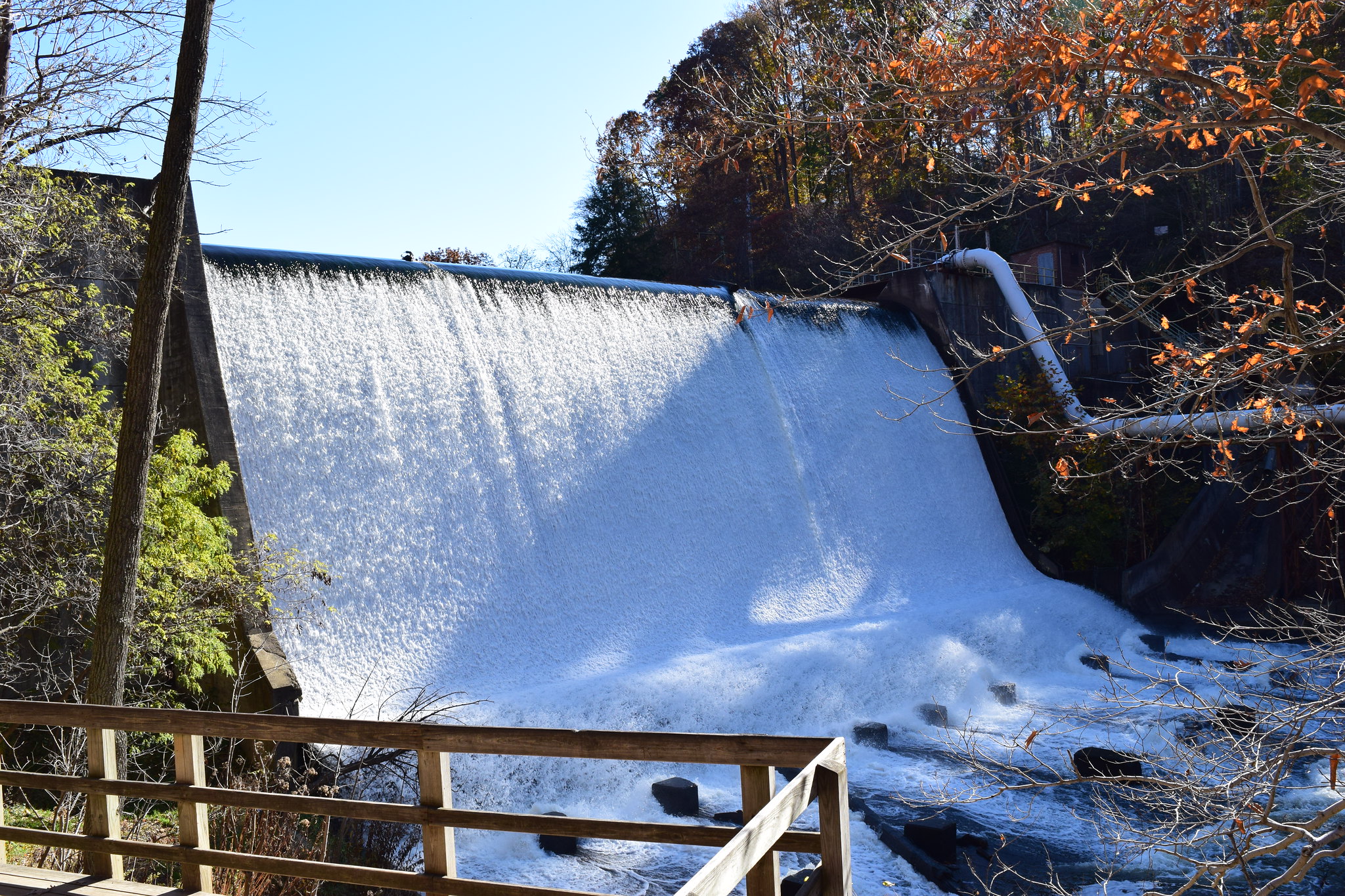
Ohio will soon embark on removing the Gorge Dam on the Cuyahoga River, but first must clean up 875,000 cubic yards of contaminated sediment at a cost of more than $100 million. The result will be a free-flowing river, a healthier ecosystem, improved habitats for fish and wildlife, and expanded public access for fishing and whitewater rapids for kayaking. Ohio’s collaborative funding approach could be a model for cleaning up contaminated sediments in Michigan’s Detroit and Rouge rivers.
About the Gorge Dam
Located in Gorge Metro Park on the border of Akron and Cuyahoga Falls, Ohio, this 420-foot-wide and 60-foot-tall dam was built in 1911 for hydroelectric power and later provided cooling water for a coal-fired power plant. However, it is no longer functional and will be removed in 2026. Summit Metro Parks calls it the largest remaining water quality impediment on the Cuyahoga River. Removing the Gorge Dam is expected to uncover the waterfall after which Cuyahoga Falls was named.
Preparing for the dam’s removal
Before the dam can be removed, contaminated sediments must be remediated. This includes mechanically dredging 875,000 cubic yards of sediment laced with heavy metals, oil and grease, pesticides, and polynuclear aromatic hydrocarbons from the incomplete combustion of oil and coal. These contaminants contribute to health advisories for fish consumption, are toxic to invertebrates and other aquatic life, and can limit future shoreline modifications like removing a dam.
Contaminated sediments will be scooped out using a water-tight clamshell bucket and transported by barge to a staging area where large debris will be removed. The still-wet sediment will then be pumped through a temporary pipeline to a nearby disposal site in Gorge Metro Park.
While in the pipeline, sediments will be mixed with concrete to form a more solid material that can be contoured before it is fully stabilized. Metro Park staff said the disposal area is designed to ensure permanent stabilization of sediment mounds, minimize impacts to buried utilities, and appropriately manage stormwater. After final grading is complete, sediment mounds will be capped with soil, and the area will be planted with native trees and vegetation.
Contaminated sediment remediation will happen in 2024 and 2025, followed by dam removal in 2026.
Collaborative funding is key
The Gorge Dam project is a good example of many public and private partners co-producing knowledge, co-innovating solutions, and collaboratively funding sediment remediation so the dam can be removed, habitat rehabilitated, and recreation enhanced. The estimated cost of contaminated sediment remediation in the Gorge Dam reservoir is more than $100 million, with 65% coming from the U.S. Environmental Protection Agency through the Bipartisan Infrastructure Act and the Great Lakes Legacy Act, and 35% coming from non-federal sponsors. Nonfederal sponsor contributions will be a combination of both money and in-kind support. Thus far, the State of Ohio has committed $25 million to the project and FirstEnergy has committed $10 million.
Lessons for Michigan
Michigan faces enormous challenges with the need to remediate up to 6.67 million cubic yards of contaminated sediment on the U.S. side of the Detroit River and an estimated 458,000 cubic yards of contaminated sediment in the lower Rouge River.
The U.S. Environmental Protection Agency (EPA) and Michigan Department of Environment, Great Lakes, and Energy (EGLE) estimate a total sediment remediation project cost of more than $900 million for the Detroit River and more than $470 million for the Rouge River.
For the Detroit River, these agencies are hopeful that more than $580 million will be covered by the U.S. EPA through the Great Lakes Legacy Act and $245 million will be covered by industrial partners, leaving approximately $75 million to cover all the likely orphaned sites.
For the Rouge River, these agencies are hopeful that over $254 million will be covered through the Great Lakes Legacy Act and $200 million will be covered by industrial partners, leaving approximately $25 million to cover all the likely orphaned sites.
In total, there is a $100 million shortfall in achieving the non-federal cost share requirements. Just as the State of Ohio provided $25 million to help make the nonfederal match requirements on contaminated sediment remediation at Gorge Dam, the State of Michigan could help make up this $100 million shortfall on the Detroit and Rouge rivers’ sediment cleanup. These funds could be provided through a “special appropriation” to Michigan EGLE over three years or by adequately funding the Renew Michigan fund – which was created in 2019 within the Michigan Department of Treasury to promote the cleanup of contaminated sites, waste management, and recycling.
Indeed, last year the Michigan Environmental Council issued a sign-on letter with support from 61 different organizations calling for Michigan Governor Whitmer and state legislators to allocate state funding through the budgetary process to help meet non-federal match funding for this sediment cleanup. However, this effort was not successful.
Another way of creatively meeting these match requirements would be to get non-federal partners to provide non-monetary project support like staging areas/real estate, landfill space, technical assistance, transportation and disposal services, source control (preventing pollutants from entering waterways), and habitat rehabilitation and enhancement.
Recently, the U.S. EPA announced an estimated $450 million sediment cleanup of the Milwaukee Estuary on Lake Michigan, representing the largest single Great Lakes Restoration Initiative investment in Great Lakes cleanup. The city of Milwaukee, Milwaukee County Parks, Milwaukee Metropolitan Sewerage District, We Energies, and the Wisconsin Department of Natural Resources contributed a combination of cash and in-kind support – donations of goods and services – to meet the $170 million non-federal match requirement.
But time is of the essence for getting federal support for cleaning up sediments in the Detroit and Rouge rivers. Only three years remain of Great Lakes Legacy Act funding. If this window of opportunity is missed, there is no guarantee that comparable federal money will be available in the future.
Contaminated sediment in the Detroit and Rouge rivers is particularly challenging. People cannot see or smell it, many contaminants were discharged long before there were environmental laws, and some of the responsible industries are no longer in business. However, passing this cleanup burden onto future generations with no likely federal funding seems unjust. Metropolitan Detroit and the State of Michigan have a once-in-a-century opportunity to resolve this contaminated sediment problem for both present and future generations.
Catch more news at Great Lakes Now:
Great Lakes Moment: Creating a green oasis in southwest Detroit
Great Lakes Moment: A Detroit perspective on the 50th anniversary of the Endangered Species Act
Featured image:Gorge Dam on the Cuyahoga River near Cuyahoga Falls, Ohio (credit: Calvin Faunus/Flickr).




